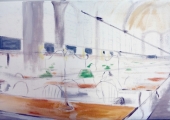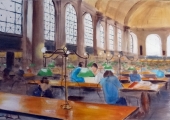New Painting: Bates Hall at the Boston Public Library
Sunday, January 4th, 2015Anyone who has been to my house in the last few years has perhaps noticed one of my paintings, which was hanging in our living room as if it was a finished painting (I don’t have enough storage space for my paintings, so works in progress are often ‘stored’ on our walls). That painting wasn’t actually finished until today.
Bates Hall is the majestic main study room in the Boston Public Library in Copley Square (click here for the BPL’s page about this room). On one of our many field trips around Boston, I took Brian to the Boston Public Library when I realized that he had never explored the library’s many art and architectural treasures. (photoblog post from that day in ’08 when we had only been together about 4 months).
It was an eye-opening experience for Brian because it was his first real glimpse of his father as a teenager, starting his lifetime career in the library industry with his first job shelving books in the spectacular halls of learning at the Boston Public Library. This past summer, Brian recalled that first visit to Bates Hall in his father’s eulogy.
I started this painting in Summer 2012, after getting a good photo of Bates Hall during my wanderings on a gorgeous day off (photoblog post from that day). Yes, it somehow took me two and a half years to complete this rather small painting. I guess I got distracted.
Also, this was probably one of the most challenging paintings I’ve ever done … partly because of the tricky perspective, partly because of so many little details, partly because it had become so important to us, but mostly because I tried two very stupid experiments with this painting. I thought it might be ‘fun’ to challenge two basic steps in starting a painting, and I now know better.
First, I didn’t sand the canvas. I usually use a very fine sandpaper to sand the gesso primer, and that gives you a nice smooth surface to paint on. I thought it might be interesting to paint on a rough texture, but it just made it hard for the paint to cover the surface. Basically, it felt like my paintbrushes weren’t working right the whole time.
And second, I didn’t start with a ground color. I usually start every painting by covering the entire surface in a basic color like yellow ochre (mixed with white) or cerulean blue (mixed with white). I thought it might be interesting to start with white, and then just simply not paint the windows. This did actually work well for the windows, but it made the rest of the painting really hard to paint. This, combined with not sanding the canvas, meant that it was just plain hard to paint in all of the details, and cover over every trace of the white canvas surface. For the longest time, I felt like I was getting nowhere with this.
But then I look back at the photos I took along the way, and I remember that this one really did come a long way! Brian worked hard on this too, providing incredibly valuable observations, suggestions, and coffee. It’s quite amazing how many of my paintings are starting to feel like our paintings.
Tags: BPL







